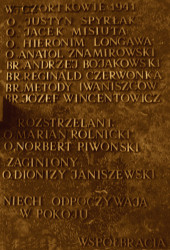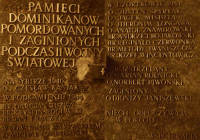Roman Catholic
St Sigismund parish
05-507 Słomczyn
85 Wiślana Str.
Konstancin deanery
Warsaw archdiocese, Poland
full list:
displayClick to display full list

searchClick to search full list by categories
wyświetlKliknij by wyświetlić pełną listę po polsku

szukajKliknij by przeszukać listę wg kategorii po polsku

Martyrology of the clergy — Poland
XX century (1914 – 1989)
personal data

surname
PIWOŃSKI
forename(s)
Ceslav (pl. Czesław)
religious forename(s)
Norbert
function
religious cleric
creed
Latin (Roman Catholic) Church RCmore on
en.wikipedia.org
[access: 2014.09.21]
congregation
Order of Preachers OPmore on
en.wikipedia.org
[access: 2013.07.06]
(i.e. Dominican Order, Dominicans)
diocese / province
St Hyacinth Polish Province
date and place
of death
09.01.1940

Gnieznotoday: Gniezno urban gm., Gniezno pov., Greater Poland voiv., Poland
more on
en.wikipedia.org
[access: 2021.12.18]
alt. dates and places
of death
07.12.1939‑12.01.1940
Wierzycetoday: Łubowo gm., Gniezno pov., Greater Poland voiv., Poland
more on
en.wikipedia.org
[access: 2021.12.18]
Mielnotoday: Mieleszyn gm., Gniezno pov., Greater Poland voiv., Poland
more on
en.wikipedia.org
[access: 2021.12.18]
details of death
After German and Russian invasion of Poland in 09.1939 and start of the World War II, after start of German occupation, murdered (gassed?) by the Germans together with „Dziekanka” — hospital for the mentally ill — stuff and patients, as part of genocidal «Aktion T4».
alt. details of death
Patients were prob. brought to execution sites in the vicinity of Gniezno and there murdered.
cause of death
mass murder
perpetrators
Germans
sites and events
Gniezno (Dziekanka)Click to display the description, «Aktion T4»Click to display the description, Ribbentrop‐MolotovClick to display the description, Pius XI's encyclicalsClick to display the description
date and place
of birth
12.07.1905

Ochotnicatoday: Ochotnica Dolna and Ochotnica Górna, Ochotnica Dolna gm., Nowy Targ pov., Lesser Poland voiv., Poland
more on
en.wikipedia.org
[access: 2022.01.28]
religious vows
26.10.1922 (temporary)
presbyter (holy orders)
ordination
23.07.1929

positions held
till 1940
patient — Gnieznotoday: Gniezno urban gm., Gniezno pov., Greater Poland voiv., Poland
more on
en.wikipedia.org
[access: 2021.12.18] ⋄ „Dziekanka” Hospital for the Mentally Ill
others related
in death
MAJCHRZAKClick to display biography Catherine (Sr Clementa), REIMANNClick to display biography Marian, TRĄBKAClick to display biography Francesca (Sr Josephine of Jesus), TRZASKAClick to display biography Henry Julian
sites and events
descriptions
Gniezno (Dziekanka): Institute and hospital for the mentally ill in Gniezno. In the period of 07.12.1939‐12.01.1940 a special German commando (special unit of German secret state police in Poznań „Sonderkommando SS”), as part of «Aktion T4», murdered c. 1,200 of the hospital patients — immediately before the start of the German occupation, there were 1,187 patients in the hospital — mainly Poles and a few Jews. The victims were given injections with sedatives and muscle relaxants — women under breasts, men in the forearm — and thus duped were driven on closed lorries — c. 40 victims to a truck — out the hospital and city. During the trip they were murdered by the exhaust fumes or gassed — some trucks were equipped with bottles with poisonous gasses. Some of the bodies were prob. buried in the nearby Mielno and Nowaszyce forests, the other in Wierzyce forests. Later, new patients were killed by German staff — the director, appointed before 09.1939, after the beginning of the German occupation began to speak only German, dismissed most of the employees, especially doctors, nurses and administrative workers, some of whom the Germans deported with their families to the General Government, and replaced them with German employees — right on the spot, in the hospital. The victims were given injections with death following very fast. Altogether during 1939‐1945 Germans murdered in c. 3,586 patients of „Dziekanka” hospital — apart from Poles and Jews also Germans from Hamburg, Rheinland and from Berlin vicinity. The victims buried in the forests were probably exhumed and burned by the Germans in 1943. (more on: pl.wikipedia.orgClick to attempt to display webpage
[access: 2013.12.27], www.dziekanka.netClick to attempt to display webpage
[access: 2013.12.27])
«Aktion T4»: German state euthanasia program, systematic murder of people mentally retarded, chronically, mentally and neurologically ill — „elimination of live not worth living” (Germ. „Vernichtung von lebensunwertem Leben”). At a peak, in 1940‐1941, c. 70,000 people were murdered, including patients of psychiatric hospitals in German occupied Poland — German formalists noted then that, among others, „performing disinfection [i.e. gassing] of 70,273 people with a life expectancy of up to 10 years saved food in the amount of 141,775,573.80 Deutschmark”. From 04.1941 also mentally ill and „disabled” (i.e. unable to work) prisoners held in German concentration camps were included in the program — denoted then as «Aktion 14 f 13». C. 20,000 inmates were then murdered, including Polish Catholic priests held in KL Dachau concentration camp, who were murdered in Hartheim gas chambers. The other „regional extension” of «Aktion T4» was «Aktion Brandt» program during which Germans murdered chronically ill patients in order to make space for wounded soldiers. It is estimated that at least 30,000 were murdered in this program. (more on: en.wikipedia.orgClick to attempt to display webpage
[access: 2014.10.31])
Ribbentrop‐Molotov: Genocidal Russian‐German alliance pact between Russian leader Joseph Stalin and German leader Adolf Hitler signed on 23.08.1939 in Moscow by respective foreign ministers, Mr. Vyacheslav Molotov for Russia and Joachim von Ribbentrop for Germany. The pact sanctioned and was the direct cause of joint Russian and German invasion of Poland and the outbreak of the World War II in 09.1939. In a political sense, the pact was an attempt to restore the status quo ante before 1914, with one exception, namely the „commercial” exchange of the so‐called „Kingdom of Poland”, which in 1914 was part of the Russian Empire, fore Eastern Galicia (today's western Ukraine), in 1914 belonging to the Austro‐Hungarian Empire. Galicia, including Lviv, was to be taken over by the Russians, the „Kingdom of Poland” — under the name of the General Governorate — Germany. The resultant „war was one of the greatest calamities and dramas of humanity in history, for two atheistic and anti‐Christian ideologies — national and international socialism — rejected God and His fifth Decalogue commandment: Thou shall not kill!” (Abp Stanislav Gądecki, 01.09.2019). The decisions taken — backed up by the betrayal of the formal allies of Poland, France and Germany, which on 12.09.1939, at a joint conference in Abbeville, decided not to provide aid to attacked Poland and not to take military action against Germany (a clear breach of treaty obligations with Poland) — were on 28.09.1939 slightly altered and made more precise when a treaty on „German‐Russian boundaries and friendship” was agreed by the same murderous signatories. One of its findings was establishment of spheres of influence in Central and Eastern Europe and in consequence IV partition of Poland. In one of its secret annexes agreed, that: „the Signatories will not tolerate on its respective territories any Polish propaganda that affects the territory of the other Side. On their respective territories they will suppress all such propaganda and inform each other of the measures taken to accomplish it”. The agreements resulted in a series of meeting between two genocidal organization representing both sides — German Gestapo and Russian NKVD when coordination of efforts to exterminate Polish intelligentsia and Polish leading classes (in Germany called «Intelligenzaktion», in Russia took the form of Katyń massacres) where discussed. Resulted in deaths of hundreds of thousands of Polish intelligentsia, including thousands of priests presented here, and tens of millions of ordinary people,. The results of this Russian‐German pact lasted till 1989 and are still in evidence even today. (more on: en.wikipedia.orgClick to attempt to display webpage
[access: 2015.09.30])
Pius XI's encyclicals: Facing the creation of two totalitarian systems in Europe, which seemed to compete with each other, though there were more similarities than contradictions between them, Pope Pius XI issued in 03.1937 (within 5 days) two encyclicals. In the „Mit brennender Sorge” (Eng. „With Burning Concern”) published on 14.03.1938, condemned the national socialism prevailing in Germany. The Pope wrote: „Whoever, following the old Germanic‐pre‐Christian beliefs, puts various impersonal fate in the place of a personal God, denies the wisdom of God and Providence […], whoever exalts earthly values: race or nation, or state, or state system, representatives of state power or other fundamental values of human society, […] and makes them the highest standard of all values, including religious ones, and idolizes them, this one […] is far from true faith in God and from a worldview corresponding to such faith”. On 19.03.1937, published „Divini Redemptoris” (Eng. „Divine Redeemer”), in which criticized Russian communism, dialectical materialism and the class struggle theory. The Pope wrote: „Communism deprives man of freedom, and therefore the spiritual basis of all life norms. It deprives the human person of all his dignity and any moral support with which he could resist the onslaught of blind passions […] This is the new gospel that Bolshevik and godless communism preaches as a message of salvation and redemption of humanity”… Pius XI demanded that the established human law be subjected to the natural law of God , recommended the implementation of the ideal of a Christian state and society, and called on Catholics to resist. Two years later, National Socialist Germany and Communist Russia came together and started World War II. (more on: www.vatican.vaClick to attempt to display webpage
[access: 2023.05.28], www.vatican.vaClick to attempt to display webpage
[access: 2023.05.28])
sources
personal:
www.straty.plClick to attempt to display webpage
[access: 2019.04.16]
bibliographical:
„Martyrology of the Polish Roman Catholic clergy under nazi occupation in 1939‐1945”, Victor Jacewicz, John Woś, vol. I‐V, Warsaw Theological Academy, 1977‐1981
LETTER to CUSTODIAN/ADMINISTRATOR
If you have an Email client on your communicator/computer — such as Mozilla Thunderbird, Windows Mail or Microsoft Outlook, described at WikipediaPatrz:
en.wikipedia.org, among others — try the link below, please:
LETTER to CUSTODIAN/ADMINISTRATORClick and try to call your own Email client
If however you do not run such a client or the above link is not active please send an email to the Custodian/Administrator using your account — in your customary email/correspondence engine — at the following address:

giving the following as the subject:
MARTYROLOGY: PIWOŃSKI Ceslav
To return to the biography press below:
 Click to return to biography
Click to return to biography









